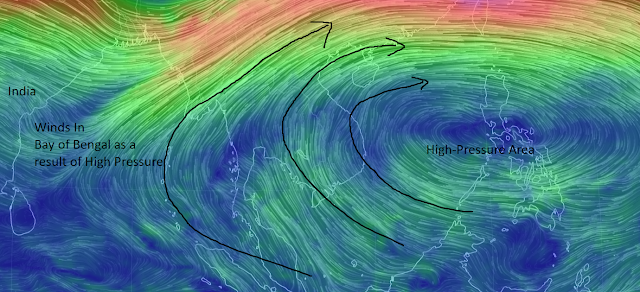Pre-Monsoon Cyclonic system in Bay Of Bengal. Can it make a move towards India ? :
Summer Cyclones in Bay of Bengal basin are a part of Climate cycle that are generated by Energy flow from Pacific to North-Indian Ocean. The energy is depicted in the form of Sea Surface Temperatures from where the energy is supplied to Cyclone. The central pressure in the Cyclone drags this energy and deepens. This deepening pulls winds from all directions and due to earth rotational effect, the winds circle around the center and this is what a Cyclone is. Along with the winds, clouds will be dragged causing rainfall along wherever the cyclone moves.
Figure-1-Hurricane (Cyclone) Isabel seen from International Space Station in 2003.
The pre-Monsoon period in India is a period of Heat Waves, Un-seasonal rains, Hailstorms, floods and Cyclones that damages the crop yield there by affecting the Country revenue and Farmer's hopes. It is important for all of us to realize the importance of Pre-Monsoon/Summer period. A better forecast will cause savings in Millions. Now we will proceed to the nature of Pre-Monsoon cyclones.
Nature of Pre-Monsoon Cyclones in Bay Of Bengal:
The Pre-Monsoon Cyclones in Bay Of Bengal normally initiate its process close to Equatorial Indian Ocean, where the actual process begins. While its formation, the intense heat along the surface of Oceans cause it to intensify more rapidly. Now we are in the stage where we understand how cyclone forms and what causes it to feel more energized. Now we can take a deep dive on how cyclones in April/May affect the Indian Coasts:
Figure-2: % Tropical Cyclones that strike in Different parts along Bay Of Bengal from 1920-2020 (100 years Cyclone data-WMO)
As we see in Figure-2, the Cyclones most probably hit Burma (Myanmar), while Sri Lanka remains at the lowest. From the above graph, we can also realize that cyclones forming in South Bay of Bengal or near the Andaman and Nicobar Islands travel more in North and North-easterly direction due to the upper-level winds. As cyclone intensifies, it reaches more height, so it mainly follows the upper level winds and thus Burma feels the upper hand in getting affected by a pre-monsoon cyclone. The Figure-3 depicts the Upper-level winds. See the winds are moving towards North-east direction.
Figure-3: Upper-level Winds in Pacific and Bay of Bengal basin.
I have marked three arrows, that indicates the Wind Direction in which cyclones Normally moves. It is important to note that the above chart will not remain the same forever during Summer. If the High Pressure over Philippines moves North, the winds in Bay of Bengal will be in South-East, this will create more probability for Andhra Pradesh and Odisha instead. But in common, cyclones during pre-monsoon times move more Northerly.
Figure-4: Pre-Monsoon Cyclones In India (April/May Season) in North-Indian Ocean Basin. Source-RSMC/IMD.
Figure-5: Pre-Monsoon Cyclones hitting Andhra Pradesh (April/May Season). Source-RSMC/IMD.
Now we are clear that the Pre-Monsoon Cyclones:
- Move more in Northerly or sometimes North-easterly direction
- Have a high tendency of Landfall in Burma.
- Summer cyclones re-curve (turn their direction) due to the upper-level winds as they gain Intensity.
- If the starting (initial) pulse of Cyclone forms close to Sri Lanka, it moves north affecting SriLanka, Tamil Nadu and Andhra Pradesh coasts. If upper winds favor, the Landfall will happen in any of these places.
- Example: Cyclone Roanu in 2016 formed close to Sri Lanka. It gave a bounty rainfall to Sri Lanka, Tamil Nadu and Andhra Pradesh.
Figure-6: Track of Cyclone Roanu in 2016. Due to the Upper-level winds are in the direction of North-east the cyclone moved away from India. But it gave good rainfall.
- If the starting pulse is somewhere in the mid point of South-Bay of Bengal, it is unlikely to reach Tamil Nadu and Sri Lanka coast. Further it will move towards Andhra Pradesh and more northern reaches of Bay of Bengal. Provided the Upper-level winds are South-East.
- Example- 1990 Cyclone of Andhra Pradesh, formed in Mid part of South Bay of Bengal. This gained strength and hit Andhra Pradesh coast with enormous power, causing causalities.
Figure-7: Track of 1990 Summer Cyclone to Andhra Pradesh. One devastating Cyclone after Diviseema Uppena (1977 Super Cyclone).
Now we have got all the power and knowledge to understand the forecast i give as as part of Forecast-1:
- First-of all, the Numerical weather models project their views in different ways:
- ECMWF - This model has a good credibility for Short (1-3 days) and Medium Range (3-6 days) in North-Indian Ocean Basin. This model in its latest Run predicts the initial pulse to form close to Sri Lanka coast. But the time for this forecast to happen is more than 7 days.
Figure-8: ECMWF latest Forecast. Taking the system close to Central Tamil Nadu coast. Map Source: weathernerds.org
- GFS - This model has a good credibility for (0-36 hours) in North Indian Ocean Basin. This model suggests the tropical pulse forming in Andamans. Due to upper-level winds, it will re-curve and move to Burma, as usual.
Figure-9: GFS latest Forecast. Taking the system into Mid-Central Bay of Bengal. Map Source: weathernerds.org
- CMC/GEM - This model is a mimic to ECMWF in long-range. Has a good credibility in giving best estimate in Long-range (5-7 days) forecast. Its showing the cyclone to move towards Andhra Pradesh after 10 days period, starting from now.
Figure-10: CMC/GEM latest Forecast. Also taking the system into Mid-Central Bay of Bengal. Map Source: weathernerds.org
- Other-models - Remaining models following Climatological pattern, moving the system towards Burma/Bangladesh.
Key-Conclusions:
From the above things we currently can't arrive at conclusions/consensus. We rather put forward two things here:
- Since ECMWF and CMC/GEM models expecting the system to remain weak for next 5 days. The system will remain weak and it will slowly drift west by surface to mid Level winds.
- Since GFS is not showing any signs of system improvement for next 48 hours, it will remain in some unconscious state for some period.
- We can also confirm that there is a possibility of a system in Bay of Bengal in 2nd week of May.
Thanks for giving your valuable time for reading this blog post. Please let me know if there are any questions/Feedback reading this post.
Will be updating the next forecast with deep insights. Till that time let's chill with our Normal lives.
Email ID - saipraneeth836@gmail.com











No comments:
Post a Comment